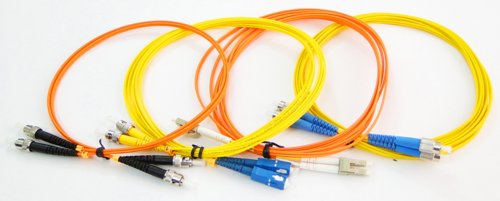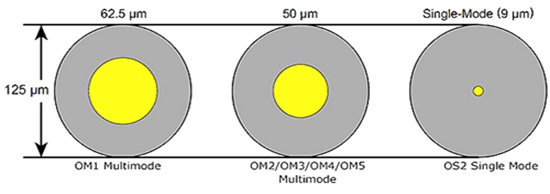What are Fiber Patch Cables?
Fiber patch cord is seeing broad adoption in applications spanning telecommunication and data communication. With numerous business and enterprise reaping great benefits from it, fiber patch cord represents by far the most sufficient and prevalent bandwidth feeder. As those gigabit-capable networks proliferate, the fueling capacity and speed quest further drive fiber patch cord deployment. When facing various fiber patch cord types on the market, how can we make a valid choice? Some basic understanding of the fiber patch cord would be helpful.

Fiber patch cables are necessary for almost all networks. Their ability to carry massive volumes of data at high speeds makes them ideal for the backbone of most networks. They connect everything from data centers to laptops to towns and countries. Fiber patch cables have become an essential component of enterprise data networks and telephony.
However, due to the variety of fiber patch cables, performance characteristics, and more exact installation requirements, many readers may be perplexed about the various fiber optic patch cables. This article will go over the things about fiber patch cables. We hope this helps to choose the right fiber patch cable for your networks.
1. What are Fiber Patch Cables?
A fiber optic patch cable, cord, or optical jumper has fiber optic connectors (LC, SC, MTRJ, ST, FC, MU, and more) at either end. These connectors allow the fiber patch cable to remain attached to an optical switch or other computing equipment. These patch cables are suited for indoor usage in server rooms, data centers, medical imaging, mechanical engineering, LAN applications, Cable TV networks, telephone lines, and other applications.
2. Why are Fiber Patch Cables So Important for Your Network?
Fiber patch cables are used in your network equipment to connect between switches and servers. If the fiber patch cables fail for some reason, it will affect the network performance or even result in complete network downtime.
3. How Does Fiber Patch Cable Works?
Light pulses are reflected off the sidewalls of the fiber optic cable as they travel down the core. Aside from the light source, no power is required to deliver a signal. Light pulses may travel long kilometers before becoming feeble and needing to be renewed.
The size of the fiber core is critical in deciding how far an optical signal will travel. In general, the smaller the core, the farther the light may go before being renewed. Single Mode Fiber (SMF) has a tiny core that keeps the light path narrow and enables it to reach up to 160 kilometers. Multimode Fiber (MMF) has a larger core that can transport more data. Still, it is prone to signal quality issues over longer distances, making it better suited to premises cabling and short-haul networks.
4. What Are the Advantage of Fiber Patch Cables?
Transmission speed. Compared with copper cables, fiber optic patch cables have a much higher transmission speed. The transmission speed is up to 400Gbps for single-mode fiber cables and 100Gbps for multimode OM4 fiber cables.
Transmission distance. Fiber optic patch cables can be connected to devices far away from each other because they are made of optical fibers that can be transmitted very far in the air or underwater. For example, multimode fiber cables can be extended up to 2 kilometers, while single-mode fiber cables can be extended up to 160 kilometers under ideal conditions.
Low attenuation rate and high immunity to noise. Fiber optic patch cords are immune to electromagnetic interference (EMI) and radio frequency interference (RFI). In addition, they have the lowest attenuation loss among all the types of cable connectors, which makes them more reliable than copper cables.
Fiber cable strands are Tiny. It has the same diameter as human hair. Their data transmission capabilities much outweigh those of their copper counterparts. Regular copper cable is four times wider and only transmits a fraction of the data. Fiber cable is lighter, more flexible, and takes up less room (and therefore easier to manage). The extra space allows for more significant cooling, more accessible access to the equipment it connects to, and a more pleasant design.
5. Singlemode vs. Multimode Fiber Patch Cable
The Singlemode fiber patch cable is an optical fiber cord that can only support one light signal. A Singlemode fiber patch cable is used in high-speed data transfer, which is designed to provide broadband internet connections.
The multimode fiber patch cable is an optical fiber cord that can support multiple light signals. A multimode fiber patch cable is used where it is necessary to carry more than one signal through the same piece of cabling.
The main difference between Singlemode and multimode patch cables is their core size. The core of a singlemode cable is much smaller than that of a multimode, making them very useful in situations where you need a long-distance transmission. Singlemode fibers are typically for enterprise networking applications and home networking setups with high-speed internet connections.
6. Simplex vs Duplex vs Ribbon
Fiber Patch CableBased on the core and cladding diameter, there are three fiber patch cables for different purposes.
Simplex fiber patch cable uses single-strand fiber. It can be used for connections within equipment cabinets or to connect multiple devices back to a single piece of equipment such as an Ethernet hub or switch.
The duplex fiber patch cable is a stranded cable containing two strands. The patch cable includes twin connectors to send and receive data concurrently. Duplex patch cables are commonly used to link high-speed network equipment, including switches, servers, and storage systems.
The last type of cable is ribbon fiber patch cable, which contains a group of fibers all bundled together into one jacket (outer covering). Ribbon fiber cables come in three different varieties: 62.5/125, 50/125, 50/125 OM3/OM4 multimode, and 9/125 singlemode.
7. Cable Connector
Ferrule Connector (FC). The FC was the first optical fiber connector to employ a ceramic ferrule. These connectors accurately position and secure the fiber core with the transmitter and receiver. FC connectors have been mostly supplanted by the cheaper and easier to install SC and LC connectors. However, they are still recommended in severe vibration settings because of their screw-on collet.
Straight Tip (ST). ST connector was the most popular fiber optic connector for both singlemode and multimode fiber at one point. It has a bayonet-style twist lock connector and is cheap and straightforward to install. It is still employed in industrial and military applications, although smaller form factors in other uses have mostly supplanted it.
Subscriber Connector (SC). SC, which stands for Subscriber Connector, has also been called Square Connector or Standard Connector. It is a common fiber-optic connector because of its low cost, longevity, and ease of installation for both point-to-point and passive optical networking.
Lucent Connector (LC). The LC connector was created to criticize that ST and SC connectors were overly large and readily dislodged. The footprint of an LC connection is roughly half that of an SC connector. LC is also a push-pull connection, but unlike SC, it uses a latch with a smaller ferrule, making it extremely common in data communications and other high-density patch applications.
Mechanical Transfer Registered Jack (MT-RJ). MT-RJs are compact, duplex fiber connectors with both fibers terminating on a single 2.45 x 4.4 mm ferrule. They are nearly half the size of SC connections and use plastic latches similar to RJ-45 connectors to attach and disengage from their ports. Two pins on transceivers provide for simple connection alignment.
MTP/MPO (Multiple-Fiber Push-On/Pull-Off). The MTP/MPO connector features a horizontal, multi-fiber interface that is optimized for use with high-bandwidth QSFP, QSFP28, QSFP-DD transceivers. The connections are roughly the same width as SC connectors, but they may be stacked vertically in patch panels and switches. They’re suited for high-bandwidth applications like cloud computing and core data centers.
CS Connector. The CS connector is a small single-position plug with two cylindrical, springloaded butting ferrules (typically 1.25 mm in diameter) and a push-pull coupling mechanism. The connectors’ optical alignment mechanism is either a stiff bore sleeve or a resilient sleeve. CS connectors are the next stage in giving higher performance while reducing the size by 40%. These miniature connectors enable a 40% horizontal size reduction over the LC duplex and are QSFP-DD and OSFP compliant.
SN Connector. SN Connector is a next-generation connector designed by SENKO Advanced Components. This innovative duplex connector, optimized for 400G transceivers, is an alternate solution for next-generation high-density Data Centers, Hyperscale, Edge, and Enterprise environments.
Enterprise Systems Connection (ESCON). IBM designed Enterprise Systems Connection (ESCON) in the early 1990s as a serial half-duplex optical fiber interface to connect mainframe computers to peripheral devices such as tape drives, hard drives, and disk storage devices. The previous, more expensive, and slower copper-based parallel bus and tag channel technology was superseded by ESCON.
E2000 (LSH) Connector: The E2000 Connector is a few fiber optic connectors with a spring-loaded shutter that completely shields the ferrule from dust and scratches.
MU connectors. It was developed by NTT. The MU connectors are made of plastic and have 1.25mm Zirconia ferrules. MU connectors are optical connectors that have been miniaturized and enhanced in terms of density, applicability, and performance.
8. Cable Polishing
PC Fiber Patch Cable. PC fiber patch cable refers to the fiber patch cord that is polished in the physical contact style. It is the most commonly found polish type on OM1 and OM2 multimode fiber.
UPC Fiber Patch Cable. UPC fiber patch cable refers to the fiber patch cord that is polished in the Ultra Physical Contact style. It is an advancement of the PC fiber patch cable with a better surface finish after extensive polishing and a lower return loss than the PC structure, approximately -50dB or higher.
APC Fiber Patch Cable. It refers to a fiber patch cord with an APC connector. APC Connector is an abbreviation for Angle Polished Connector. Take note of the angled tip of the white ceramic. This angle eliminates back reflections, which significantly reduce the performance of any analog fiber optic system, such as CATV and satellite.
9. Cable Jackets
The National Electrical Code (NEC) specifies fire resistance limits for fiber optic cables. Indoor fiber installations are often categorized as a plenum, riser, or general-purpose. Fiber patch cables placed in plenum areas and risers must fulfill the flame spread and smoke generation criteria established in NEC Article 770 and the UL 1651 Standard for Optical Fiber Cable.
OFNP is an abbreviation for Fiber Optic Non-Conductivity Plenum. OFNP fiber cables are resistant to fire and smoke. They may be inserted in pipes, plenums, and other areas where gas streams are being built. This is the highest degree of fire-rated cable; no other cable may be used in its place.
OFNR is an acronym that stands for Optical Fiber Nonconductive Riser. OFNR fiber cables are employed in Riser regions, which are used to create vertical shafts or run from one level to another. OFNR fiber cables cannot be put in the ventilation area because they lack the fire and smoke ratings needed by Plenum-approved cables. OFNP plenum cables can be used in place of OFNR fiber cables.
OFNG refers to Optical Fiber Nonconductive General-Purpose. They are often utilized for single-layer horizontal wiring applications. OFNP and OFNR cables can be used in place of OFNG cables.
10.
Optical Return Loss
Optical Return Loss is the ratio of light reflected by the light source over the whole fiber link. It is always measured in decibels (dB) and is usually a negative number. The greater the number’s proximity to zero, the greater the reflectance (a poor connection).
Optical Insertion Loss
Insertion loss is the amount of light lost between two fixed spots in a fiber. The Insertion loss can happen when optical fibers are spliced, joined, or passed through other passive components.



